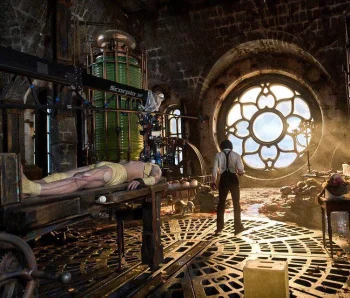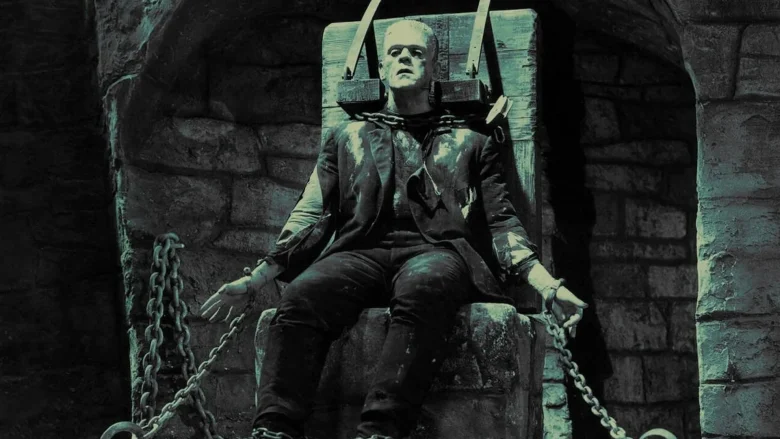FRANKENSTEIN (On Netflix Nov. 7th) arrives on a sea of good will knowing Mexican director Guillermo del Toro, our master of gossamer fantasies, at last realized a life long dream. He’s faithfully brought Mary Shelley’s sprawling novel to life while lifting some key story elements from James Whale’s BRIDE OF FRANKENSTEIN rightly cited as the high-water mark of the classic Universal horror cycle.
That’s a tough assignment and del Toro goes big. With its eye grabbing production design and ginormous sets, free of CGI, it seemingly screams to be devoured on the big screen. Still, don’t feel deprived if you missed its brief theatrical run. Its gripping lead performances, verbose dialogue and over reverence for the source material gives it a Masterpiece Theater feel well suited for couch viewing– more a Valentine to Shelley and Whale than a Halloween treat.

As director and writer, del Toro shrewdly segments Shelley’s sprawling tale into two halves – Victor Frankenstein’s story and then his creature’s. In the leisurely paced first half, young Baron Victor (Christian Convery) is a poor little rich boy, whipped by his demanding physician father (Charles Dance) while mourning the death of both his mother and an unborn sibling. Victor grows into a fervent, haughty medical student (a sufficiently obsessed Oscar Issac) vowing to conquer death. When he reanimates a corpse, a grotesque mass of flesh, he’s tossed from the Royal College of Surgeons of Edenborough and treated like a heretic.
Luckily, Heinrich Harlander (Christoph Walz), a rich arms manufacturer, is Victor’s financial patron and houses him in a foreboding abandoned munitions factory to do his work sans any hunchbacked assistant. This first half of exposition has real bite as Victor builds his creature from parts sawed from corpses on the battlefields of the Crimean War and warmer bodies waiting to swing from the gallows in public hangings.
When the creature is brought to life, Victor tries to school his shackled creation but soon loses patience with its mental state. Elizabeth, his brother’s fiancée (Mia Goth), sympathizes with the creature who, rejected by its creator, is cast adrift in the second half.
Jacob Elordi does extraordinary work as the creature, staggering through snowy forests and trying in vain to bond the humans who attack him. Any filmmaker tackling FRANKENSTEIN is daunted by the flat top, neck bolted make up designed for Boris Karloff by Jack Pierce. Mike Hill wisely goes his own way to strong effect with the creature’s pale skin traversed with slashes like a butcher shop diagram of a cow about to be chopped into hamburger.

When the creature learns his seemingly fatal wounds heal themselves, he’s angered that he can’t die. In a cruel twist, Victor has conquered death and that success dooms his creature for a forever life it doesn’t want. The creature vengefully pursues Victor to the Arctic where, in a repetitious framing story, they each relate their tales to a ship stranded in ice and its worried sailors.
FRANKENSTEIN undeniably earns such adjectives as “admirable,” “respectable,” “beautifully mounted,” etc. It’s a three-quadrant work that should appeal to squeamish fantasy buffs, genre fans tickled that del Toro’s wish came true and those who frankly don’t like horror without a prestige Ghoul Housekeeping Seal.
Yet pity the poor gorehound seeking a semblance of a spooky experience. FRANKENSTEIN substitutes sensation for scares and is almost completely devoid of suspense. For all his rep as a horror icon and archivist, del Toro sometimes takes a toothless approach.
Call me bloodthirsty for objecting to his first film KRONOS where the lead monster didn’t kill anyone. Here, the creature knocks some misbegotten sailors around like boiling pins; we’re told he’s offed six of them but it’s faceless mayhem like the number of anonymous assassins ballistically obliterated in some bloodless action film. That’s the same reaction when he sends several wedding guests into the next life in a donnybrook melee.

His grim Fairy Tale approach worked masterfully in his early must-sees like THE DEVIL’S BACKBONE and PAN’S LABYRINTH. Del Toro’s THE SHAPE OF WATER had more forward momentum and poignancy than FRANKENSTEIN which suffers from a talky and ambiguously upbeat ending that feels emotionally unearned. That problem rests with some head scratching script elements during key character moments.
Before the creature learns to speak, Victor is disgusted that his creature can’t master more than two words. If it’s a failed experiment, why not go back to the drawing board/graveyard? Instead, Victor inexplicably decides to abandon his dream project and destroy his entire laboratory. Why? Because it looks cool to blow things up with fireballs. And why does he immediately change his mind and rush back into a burning building? So he can have his leg blown off and then hobble on a prosthetic leg.
Other elements in del Toro’s script don’t add up. Elizabeth’s bond with the creature feels rushed. When Victor mistakenly shoots her while confronting the creature, there’s no tragic pull when the creature carries her away and she gives her farewell speech. What made Karloff’s monster in FRANKENSTEIN both fearless and sad is he accidentally killed the child he played with. Del Toro loves his monsters too much to have them be monstrous and that dulls any tragic edge. This may seem nitpicky but since del Toro chases a poignant ending, the emotions better land and for this viewer and a learned pal we were similarly unmoved. Since the first half revels in vivisection, here’s a related analogy – FRANKENSTEIN has too much heart and not enough guts.
Eric Lindbom is a hardcore horror buff with a strong stomach, weaned on the Universal classics from the ’30s and ’40s. He’s written film and/or music reviews for City Pages, Twin Cities Reader, LA WEEKLY, Request magazine and Netflix. He co-edits triggerwarningshortfiction.com, a site specializing in horror, fantasy and crime short stories with illustrations by co-editor John Skewes. He lives in Los Angeles.







